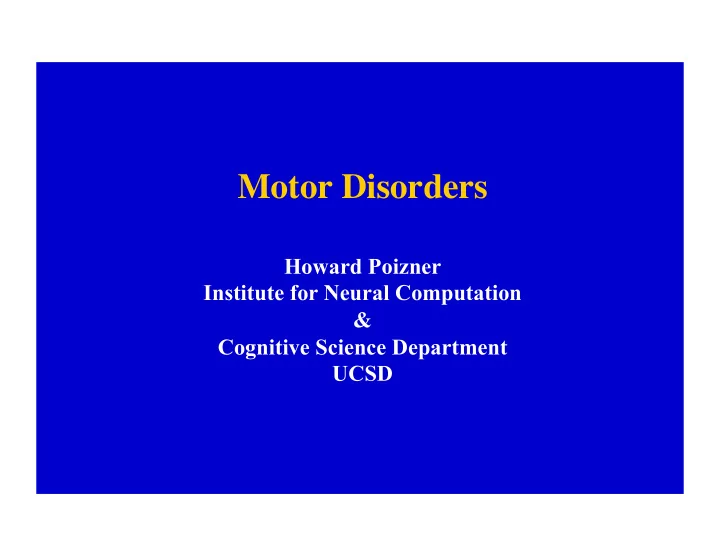

Motor Disorders Howard Poizner Institute for Neural Computation & Cognitive Science Department UCSD
• Sensory versus Motor Systems • Reason we have a brain • Breakdown of motor control following failure of sensory or motor systems • Deafferentation • Parkinson’s disease
I Cortical Motor Areas Thalamus Basal Ganglia II Brain Stem Cerebellum III Spinal Cord Muscle Contraction & Movement Final Common Path Sensory Receptors
Parkinson’s Disease • Reliance on external cues • Basal Ganglia are important for the internal guidance of movement • Point to remembered 3D locations without vision Sensorimotor Mapping Problem • How to control joint angles of arm given knowledge of coordinates of target in external space
SUBJECTS • 11 PD Patients (mild to moderate) • Studied OFF medication • 8 Age-Matched Controls • Right handed, right hand used
Conclusions for Experiment 1 • With vision only of the initial hand position and target, mild to moderate PD patients have normal 3D pointing accuracy • Thus, PD patients are able to construct spatial maps of the target and of their moving limb and coordinate the two • Certain dimensions of performance are impaired • Challenging integration of vision and proprioception may induce large spatial errors
Modes of Target Presentation 1. No-Vision 2. Finger-Vision 3. Target-Vision • No required integration across sensory modalities: Finger-Vision • Required processing of proprioception & integration with vision: No-Vision Target-Vision Hypothesis: Deficits in Conditions 1 & 3, but not in 2.
SUBJECTS • 9 PD Patients (mild to moderate) • Studied OFF Medication • 9 Age-Matched Controls
Conclusions • PD patients show large 3D reaching errors when forced to extract critical information from proprioception to map onto a spatial target • This deficit may in part underlie PD patients’ reliance on external cues • Turn to learning new sensorimotor mappings
* Biaxial Distortion Z
SUBJECTS • 8 PD Patients (mild to moderate) • Studied OFF Medication • Minimal or No Tremor or Dyskinesias • 10 Age-Matched Controls • 10 Young Adult Controls
20 20 15 15 IL IL 10 10 * RL RL 5 5 0 0 20 30 10 60 10 20 30 60 50 -5 40 50 -5 * * 40 -10 -10 * * -15 -15 * -20 -20 -25 -25 -30 -30 Young Elderly Parkinson
RL Young Elderly Parkinson IL
CONCLUSIONS • PD subjects show an endpoint elevation depression at baseline • The ability to adapt to a sudden biaxial visuomotor distortion applied in 3D space declines in normal aging and Parkinson disease • The Basal ganglia contribute to visuomotor learning, particularly when the task requires a rapid reconfiguration of newly learned visuomotor coordinations
Deafferented Subjects
Recommend
More recommend